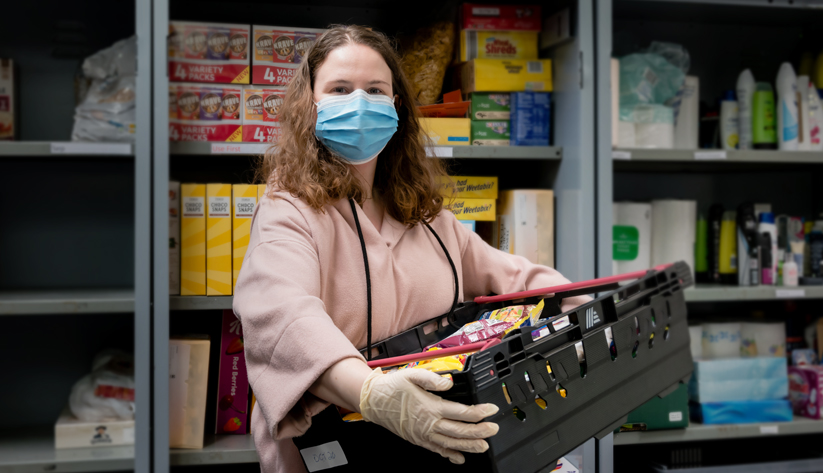
More and more Americans are finding it harder to put food on their tables as the coronavirus pandemic continues, and parts of the Southeast are among the nation’s hungriest areas.
Three of the six states in the Federal Reserve Bank of Atlanta’s coverage area—Alabama, Louisiana, and Mississippi—have the highest U.S. rates of food insecurity because of COVID-19, according to an analysis from Feeding America, the nation’s largest hunger relief organization. Among the 50 states, Mississippi leads, with more than 675,000 people, or 22.6 percent of the state’s residents, likely missing meals in the wake of the health crisis.
Alabama and Louisiana rank third and fourth, respectively, behind Arkansas on this list, with food insecurity expected to affect more than 20 percent of the total population of both states this year, the Feeding America estimates show.
Generational poverty and economic constraints continue to hamper parts of the Southeast, which has traditionally fared worse than the rest of the nation in terms of having ample resources and access to healthy nutrition (see the table).
|
Getting Enough to Eat
The number of people who lack access to enough healthy food has increased significantly during the COVID-19 crisis. This table shows the rise in food insecurity since 2018 for states in the Atlanta Fed’s coverage area. |
||||||
|---|---|---|---|---|---|---|
|
|
Population |
Share of Food-insecure Population in 2018 |
Share of Food-insecure Population in 2020 |
Number of Food-insecure Children in 2018 |
Number of Food-insecure Children in 2020 |
Increase in Food-Insecure Children from 2018 to 2020 |
|
Mississippi |
2,986,540 |
19 percent |
24 percent |
162,150 |
229,890 |
42 percent |
|
Alabama |
4,887,880 |
17 percent |
22 percent |
251,800 |
352,450 |
40 percent |
|
Louisiana |
4,659,980 |
16 percent |
22 percent |
269,650 |
378,730 |
40 percent |
|
Tennessee |
6,770,020 |
14 percent |
19 percent |
267,110 |
408,040 |
53 percent |
|
Florida |
21,299,330 |
13 percent |
19 percent |
819,370 |
1,248,910 |
52 percent |
|
Georgia |
10,519,470 |
13 percent |
18 percent |
405,380 |
640,080 |
58 percent |
Source: Research for Feeding America on the Impact of the Coronavirus on Food Insecurity, volume 1, from C. Gunderson, M. Hake, A. Dewey, and E. Engelhard (2020). State population information from the American Community Survey (2014–18).
Under normal conditions, our state has one of the highest rates of food insecurity in the country,” said Erin Brock, a New Orleans-based policy and advocacy coordinator at Feeding Louisiana, which is part of the Feeding America network. “The pandemic has shown us just how many Americans are living right on the edge.”
Joblessness still a problem
The historically high and persistent unemployment from COVID-19 has left underserved communities more vulnerable. A recently published Federal Reserve survey found that conditions in low- and moderate-income communities have worsened as the pandemic continued. Among the government agencies, nonprofits, banks and other institutions responding to the survey, 55 percent said that income loss, job loss, or unemployment effects from COVID-19 have deteriorated in lower-income areas since August.
Atlanta Fed president Raphael Bostic says the COVID-19 recovery has been uneven. (In fact, Bostic and his team of Atlanta Fed economists have taken to using to a mathematical symbol, the less-than sign, to describe present conditions as characterizing a “less-than recovery.”) Bostic told the Securities Industry and Financial Markets Association in mid-October that while grocers, online retailers, and professionals who can work from home are doing well, other segments of the economy, including industries that depend on large crowds, are weakening.
In the Southeast, hospitality and tourism have suffered greatly as leisure visitors plunged, said Cyndy Baggett, vice president of development and marketing at Feeding the Gulf Coast, a Feeding America partner that serves 24 counties in Alabama, Florida, and Mississippi. As an example, she said annual Mardi Gras celebrations provide a six-to-eight-week economic boost for Mobile, Alabama—where she lives—and other nearby communities. Having to scrap or scale back those kinds of large events “has a ripple effect across the board,” she said, hurting not only hotels and restaurants, but a wide range of workers, from designers of parade floats to costume makers.
Bostic noted that businesses with declining prospects in the wake of COVID-19 primarily employ lower-wage workers, young people, minorities, and women. “In other words, the people who are often least equipped to weather a prolonged bout of unemployment are bearing the brunt of this health crisis and economic downturn,” he said.
Minorities are among the groups having the hardest time securing the food they need. “Because Black and Hispanic families generally have disadvantaged access to resources and employment opportunities, it’s those communities where food insecurity rates have been most acute during this crisis,” said Danny Mintz, an anti-hunger policy advocate with the Louisiana Budget Project, a nonprofit that analyzes state fiscal issues. For example, U.S. Census data show that in the state of Louisiana, the percentage of white families that have difficulty affording healthy food is 24 percent; that compares with 36.5 percent of Black families and 36.9 percent of Latino households, Mintz said.
The federal coronavirus relief package signed into law in the spring—the CARES Act—provided an extra $600 a week in unemployment money to supplement workers’ state jobless benefits. That subsidy expired at the end of July. That additional weekly aid, which came to roughly $2,400 a month, “made a huge difference in the resources that families had available to buy food,” Mintz said.
Concern for children
As the level of hunger has increased, children have been especially put at risk. In Florida, for example, more than 1.25 million kids face food insecurity this year, up 52 percent from 2018, Feeding America data show. In Georgia, the number of children who lack access to adequate quantities of food has risen by 234,700, or 58 percent, from two years ago.
School shutdowns early in the health crisis brought to light a harsh reality: were it not for meals provided during the school day, many children would have nothing to eat at all.
The U.S. Department of Agriculture (USDA) has approved changes to school nutrition programs that allow new methods of food distribution, such as grab-and-go meals that parents can pick up and meal delivery to bus stops and neighborhoods. As schools offer both in-person and remote learning, rules requiring that kids be on school property to receive meals have been waived through the end of the current academic year.
During the pandemic, school districts have been partnering with food banks and nonprofit groups to distribute groceries to families as well, said Eleni Towns, associate director with the charity No Kid Hungry, who works with organizations in Alabama, Georgia, and Tennessee. “We know that child hunger is not in a silo—it’s a reflection of the food insecurity that’s in a household, and we can’t solve one without the other,” she said.
Food banks are helping to bridge the gap, but they are under pressure as lines of recipients grow longer. Last year, the Feeding the Gulf Coast network provided 24 million meals in its service area; that figure is expected to climb to 35 million to 36 million meals this year, Baggett said.
Many people showing up at food banks these days never dreamed they’d need to seek them out. “About 30 percent of the people coming to our network have never sought help before. They are accessing the emergency food network for the first time because they’ve lost their job,” said Danah Craft, executive director of the Georgia Food Bank Association, which includes seven Feeding America food banks that serve the state. Craft says since COVID-19, the food bank network she supports has seen a sustained 40 percent increase in demand, with higher rates around metro areas such as Atlanta and Savannah, where a lot of families are concentrated and job losses remain high.
Food banks retooled their operations to operate safely during the pandemic, prepacking materials at warehouses to load into vehicles of recipients who drive through large distribution centers in high-demand areas.
Federal food and aid programs have been the main source of relief for households stretched thin during the pandemic. The Agriculture Department’s Foods in Schools program provides breakfast and lunch, and afterschool programs offer meals when school ends and parents are still working. The Emergency Food Assistance Program provides food that states distribute to people with low incomes. The Supplemental Nutrition Assistance Program (SNAP), commonly known as food stamps, is the country’s largest food initiative through which funds are directly deposited into a qualifying household’s electronic benefit transfer card account. Other USDA food programs are geared specifically for seniors and residents on Native American reservations.
Even so, these programs don’t reach all who are in need. Brock said there is greater opportunity to increase participation in the Emergency Food Assistance Program, for instance, by informing income-eligible families of the need to register for the benefit and meet residency and identification requirements. A lengthy online application can be a barrier to many who are likely eligible for SNAP, but Brock added that community partners including food banks can help people sign up for the program. “In Louisiana, we see folks who would be eligible for SNAP but may not understand it, may have misperceptions about it, or think other people need it more,” Brock said. “There’s a lot of stigma around accessing SNAP,” a program that can be socially and politically contentious, she added.
With winter approaching, food banks are growing concerned about food shortages and the quantity of supplies that will be available to them. Buying bulk supplies from retailers has become more difficult and drawn out, a result of the high demand that has disrupted grocery stores’ supply chains. Additionally, the Farmers to Families Food Box program, which the USDA launched in the spring to redirect unsold produce, meat, and dairy goods from farms to food banks, is winding down and will lapse at the end of December.
“The rise in demand and the decrease in availability of food has presented numerous challenges,” said Baggett. Declines in donations from retail store partners that are seeing high demand for groceries have necessitated obtaining food from other sources, and those shipments take longer to arrive. “We don’t really know for the foreseeable future how we will fill those gaps if things don’t level off,” Baggett said. “Those are concerns we have as we look at 2021.”




